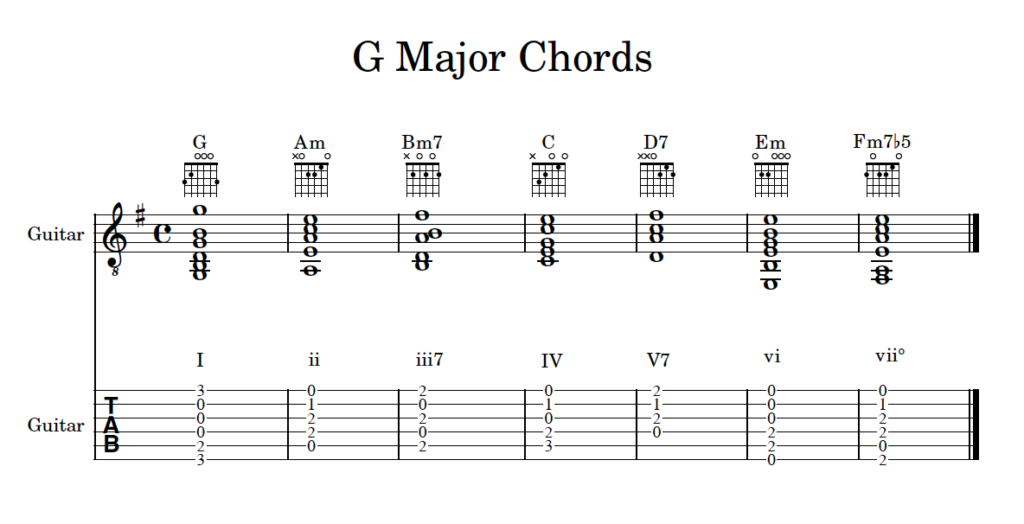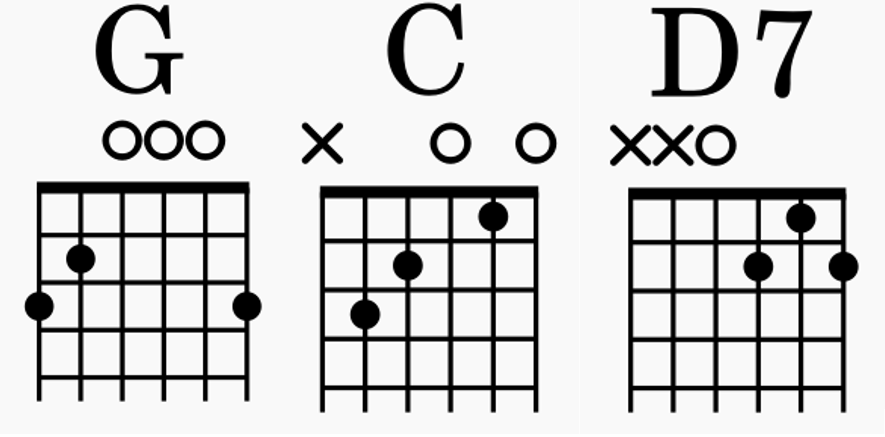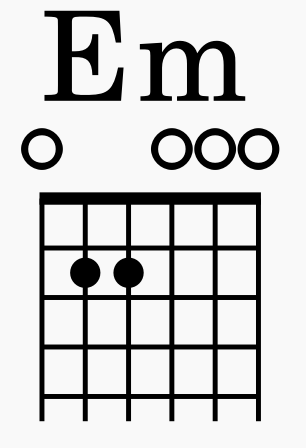What Are the Best Chords to Master When You First Learn Guitar?

Learning the guitar is exciting, but it can be overwhelming. You have all these frets and strings, some of which make the same sounds (like the 5th fret on the low E string and the open A string). How to make sense of all this? A good way to start is by picking a key and learning its chords. The key of G major is a good key for the guitar (G for “guitar”), because there are specific chords that can be easier to learn and get you playing some songs!
Chords in G Major
There are seven chords total in the key of G major: G, Am, Bm, C, D, Em, and F#m7♭5. Here they are pictured below (fig. 1):

The Roman numerals above the tablature staff denote what we call “scale degrees.” Upper case numerals are major chords, lower case are minor chords. That little ° symbol after the seventh scale degree refers to the m7♭5 (“minor seven flat five”) quality of that chord, which is also called a “diminished chord.” That chord isn’t very popular outside of jazz because of how it sounds (and therefore functions), so we’ll stay away from that one for now.
The chords I recommend learning first are: G (I), C (IV), D7 (V7), and Em (vi). Many songs are only three chords, but what’s one more? You’re up for a challenge, right? These four chords are called “open chords” due to the fact that they use open strings, and the root note is the lowest pitch. Two songs that use these chords are “Ring of Fire” by Johnny Cash, and “I Won’t Back Down” by Tom Petty & The Heartbreakers.
Ring of Fire – Johnny Cash
Cash’s song uses a capo on the first fret, as seen in this performance video. A capo is a clamp that shortens the neck of the guitar, which allows you to change the key and still use the same chord shapes higher up on the neck (this is a must-have accessory for all guitar players). In this case, the key has been changed to G#, though we will still refer to the shapes by the same name. We are discussing this song first because it only uses three chords: G, C, and D7 (fig. 2).

This grouping of chords is referred to as the I/IV/V chord progression, which is common in all Blues-influenced music (including country). They are also easy to change between. If you’re intimidated by chord changes, realize that the idea is to get between them with as little movement as possible. One way to figure this out is by looking at the things two chords have in common. For example, D7 and C share a note on the first fret of the B string, played by finger 1. That means you don’t have to pick that finger up to move between the two chords! Another commonality is finger 2 stays on the second fret for both chords, though it moves from the G string on D7 to the D string on C.
I Won’t Back Down – Tom Petty & The Heartbreakers
Once you’ve learned the three chords for “Ring of Fire,” you only need to learn one more for “I Won’t Back Down” by Tom Petty & The Heartbreakers: E minor (fig. 3). The intro actually starts with this chord, then flows through D7 and G.

E minor is an easy chord to learn since it only uses two fingers. It’s also easy to get to from G major. Even though there are two ways to play this version of the G major chord (either with fingers 1, 2, and 3; or 2, 3, and 4), changing between them is simple. Whichever finger you’re using on the second fret of the A string doesn’t need to move between these two chords. Are you starting to see the pattern with chord changes? Look for similarities and try to change chords with as little movement as possible. The rest is training your muscles to get used to the movements with plenty of repetition.
Conclusion
I hope I’ve cleared up some confusion for you regarding getting started on guitar. It’s easier than you thought, but that doesn’t mean it’s not hard work. If you would like private guitar lessons from the safety of your own home, consider checking out TakeLessons to find the right online teacher for you. We also offer online guitar classes in a group setting for all skill levels. Feel free to reach out to me with questions!
I created all the graphics for this article, so they’re good to use.
